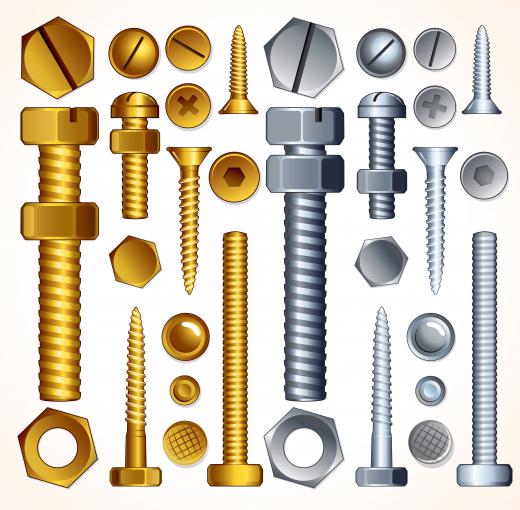At AboutMechanics, we're committed to delivering accurate, trustworthy information. Our expert-authored content is rigorously fact-checked and sourced from credible authorities. Discover how we uphold the highest standards in providing you with reliable knowledge.
What Is an Anodized Screw?
An anodized screw is a special type of metal fastener where the natural oxidation on the surface of the metal has been enhanced for a variety of reasons. Anodized products can be treated in this manner for color coding them such as in their use in surgery in the medical field, and to provide an increased level of resistance to wear and corrosion. The most common type of metal that is anodized as of 2011 for an anodized screw is aluminum due to its natural corrosion resistance over that of harder metals like steel and iron. Other types of metals that can be made into an anodized screw for special applications include magnesium and titanium screws used in high-stress metal parts such as in aircraft frame design.
The anodized screw is often used for the assembly of structures exposed to natural weather conditions, along with other types of these anodized fasteners such as anodized bolts. The surface coating for most anodized products is an oxide of the base metal itself, with aluminum having an anodized surface of aluminum oxide, Al2O3. These coatings are very durable as compared to other types of corrosion-resistant surfaces because they are an integral part of the underlying molecular structure of the metal itself that is strongly bonded to it. The disadvantage to an anodized screw is that the surface is prone to breakdown in high alkaline or acid environments. Since the anodizing process also creates a very thin surface layer that usually ranges from 2 microns to 25 microns in depth, it can become brittle and crack or flake off with age and wear.

Anodized products are also fairly common in the jewelry industry where a titanium oxide layer is surface coated onto other metals such as nickel. This is done because titanium can come into contact with the internal or external surface of the body through jewelry or medical implants without causing any kind of adverse reaction, whereas other commonly-used metals like nickel can cause allergic responses in some individuals. Titanium anodized screw fasteners are often used, therefore, to hold together medical devices and implants.
An additional benefit of an anodized screw or other fastener is that the surface has a lower friction coefficient than the base metal, known as a non-galling surface, which allows for moving parts to operate with less of a likelihood of jamming. One of the main applications that takes advantage of this feature is in gun sights and screw thread controls where the screw is used to finely adjust a setting on a machine part or instrument panel gauge. The lower level of friction also makes an anodized screw easier to clean of grease and residue when it gets coated in these parts over time.
There are two main types of anodizing process, including hard anodizing or hardcoat anodizing, and bulk anodizing, both of which utilize sulfuric acid. Hard anodizing is done through the application of electrical current in an electrolyte bath usually to aluminum parts larger than screws, and this type of coating can be stronger than case-hardened steel when completed. Bulk anodizing is done to batches of small parts with odd shapes such as an anodized screw or rivet, where they are coated together in large numbers in plastic or titanium baskets. The sulfuric acid in both processes serves to oxidize the surface layer of the metal and can simultaneously be used to give it a texture or color. One of the anodized products where these effects are most noticeable are in non-stick cookware and cooking utensils.
AS FEATURED ON:
AS FEATURED ON:











Discuss this Article
Post your comments